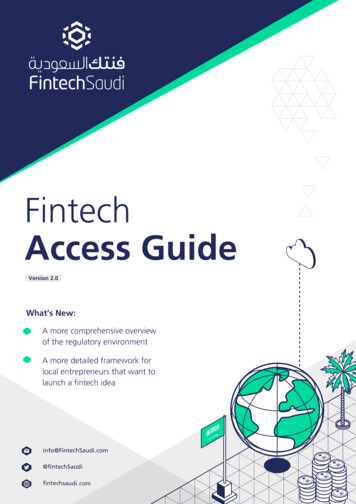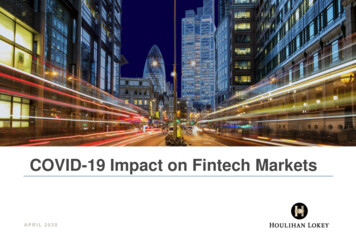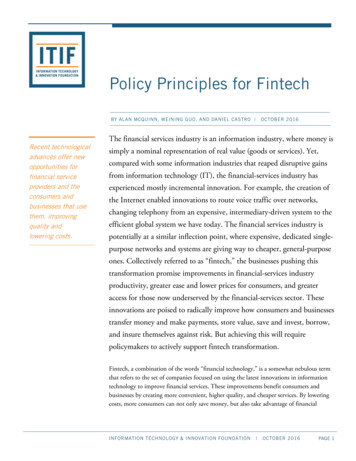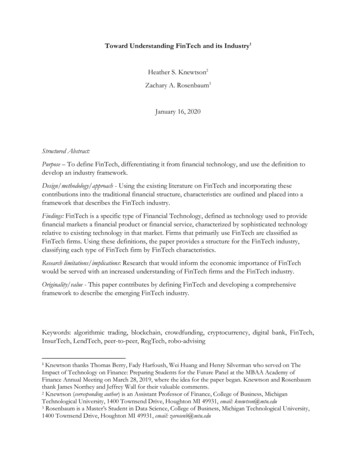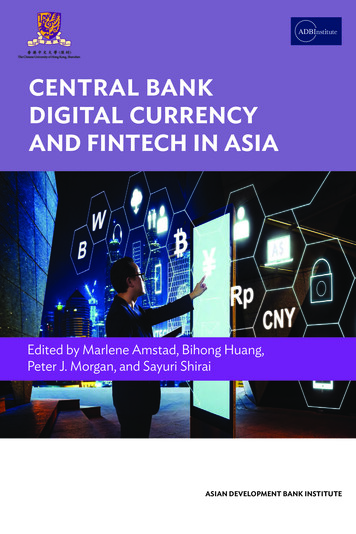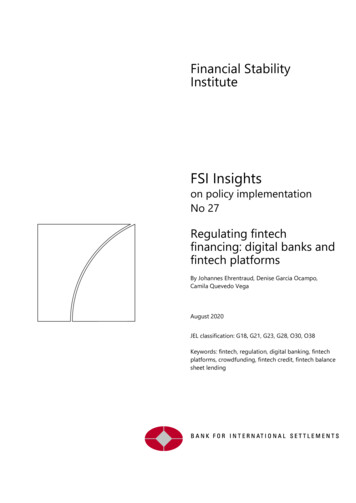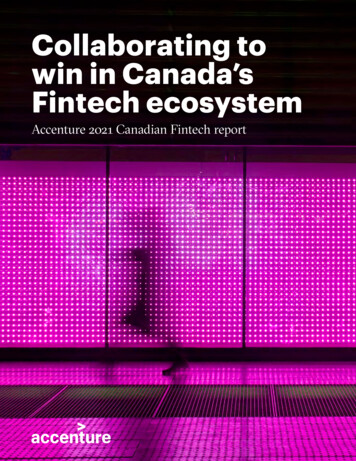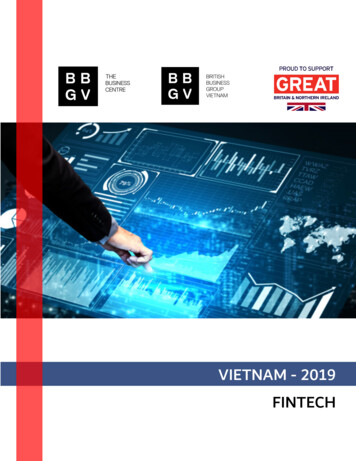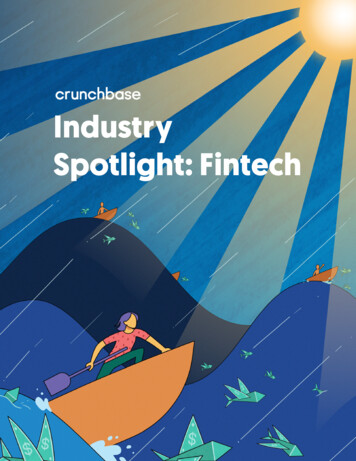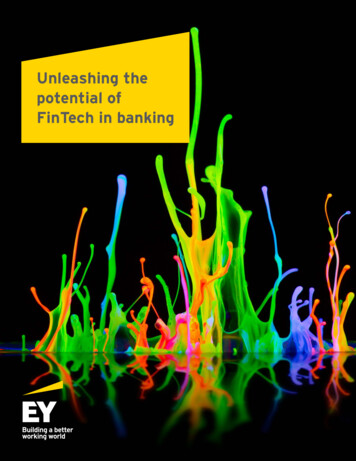
Transcription
Unleashing thepotential ofFinTech in banking
ContentsExecutive summary 3Partner or perish: actions for banks 6Partner or perish: actions for FinTechs 14Embedding FinTech in the banking ecosystem 20
Executive summaryThe FinTech industry attracted over US 13.1b inVC-backed investments in 2016, about five timesmore than investments four years earlier (see Figure1). The growth of the industry has strengthened thecommon belief that FinTech will disrupt banking. Butcollaboration — not competition — will be the primarydriver of disruption.The biggest near-term threat to most banks comesnot from FinTechs but from traditional competitorsbetter leveraging those FinTechs. Our analysis of45 major global banks reveals that while all banksare engaged with FinTechs one way or another,only around a quarter are extensively engageddue to barriers to collaboration with FinTechs.In this report we look at some of the commonbarriers to effective collaboration — from navigatingprocurement and vendor risk management totechnical implementation — and how banks andFinTechs can overcome them.Unleashing the potential of FinTech in banking 3
Figure 1: Annual global financing trend to VC-backed FinTech 01420152016US bDealsSource: CB InsightsEY FinTech Adoption Index1 highlights the consumers’ rapiduptake in recent years of financial services offerings from newinnovative companies, while EY Global Consumer Banking Survey2016 emphasizes how the accessibility of these new technologiesappeals to customers and calls on banks to innovate like FinTechs.But it is not just on the front line of consumer banking that wesee disruption.So why are levels of collaboration not far greater? For FinTechs, itcan be a struggle to negotiate the long procurement cycles of bigbanks. For banks, it’s a challenge to successfully implement cuttingedge technology in large organizations based on IT from the 1970s.In our experience of working with both banks and FinTechs, theseare commonly cited barriers to unleashing the potential of FinTechto transform banking businesses.Regulators see the benefits of — and, in fact, expect banks to use —regulatory technology (RegTech) to improve processes. Meanwhile,an array of rapidly advancing technological innovations, fromrobotics to artificial intelligence and machine learning, offer banksnew ways to transform their businesses without replacing corebanking systems.In 2016, the average return on equity (ROE) for the largest 200global banks was just over 7.1%. To achieve an ROE of 12%, thetop 200 global banks need to increase their revenues by 15% andreduce costs by 13.7%. Engaging with FinTechs, part of a broaderbanking ecosystem, will help banks drive down costs, innovate andenhance customer service.Initiatives such as Open Banking in the UK and the PaymentsServices Directive II (PSD II) in Europe, combined with the EU’sGeneral Data Protection Regulation, as well as the development ofcommercial banking aggregator models — especially in the US — aregiving customers more control of their data, held by banks.As banks look to rebuild sustainable ROE, they must build betterecosystems. These will be founded on collaboration with FinTechfirms, industry utilities and an array of other service providers— to help reduce structural costs, enable enhanced regulatorycompliance and better serve customers.At the same time, FinTechs increasingly recognize the significantcosts of customer acquisition in financial services and barriersto cross-border business that banks are well-equipped to bridge.Furthermore, more emerging FinTechs recognize the opportunityto have a role as part of a broader banking ecosystem, developingtechnology that can help transform an industry, not just supportone bank.1“EY FinTech Adoption Index,” EY, 2017.
Unless banks and FinTech firms get better at workingtogether, neither will reap the full benefits of innovation.Banks are seeking ways to benefit from deploying FinTech acrosstheir organizations. Our analysis of data from 45 major banksover the last three years suggests that, globally, institutionsremain principally focused on applications of FinTech in payments.However, they are increasingly looking to use FinTech across theentire value chain, from gamification of compliance training tosurveillance software that can identify employees who pose thegreatest organizational risk, and from using artificial intelligence toimprove customer service to driving greater workforce productivity.But picking the right FinTechs to collaborate with and successfullyimplementing new technologies remain challenging for banks thathave weak innovation cultures. FinTechs, for their part, need tobetter articulate the clear benefits of their technology and workwith banks to deliver change.In this report, we explore how banks and FinTech firms can bettercollaborate to reap the benefits of new technology. The globalFinTech industry is growing rapidly, driven by a powerful blendof innovative start-ups and major technology players. Banks thatwant to leverage this potential must act now to find ways to engagewith these innovative organizations to achieve value-creatingcollaboration.Unless banks and FinTech firms get better at working together,neither will reap the full benefits of innovation. They must partner,or they may perish.Figure 2: The partnership imperatives and opportunities for banks and FinTechsBanksFinTechsChoose innovationoperations modelDifferentiate withregulatory prowessDevelop FinTechinnovation frameworkAssess FinTechengagement strategiesArticulatevalue propositionManagetalent andarchitecturalchangeBe prepared andwell-networkedBuild a robustbusiness caseUnleashing the potential of FinTech in banking 5
Partner or perish: actions for banksBanks have many innovative ideas; the challenge is validating which to actively pursueand embedding the technology. The complexity, scale and siloed nature of banks meanthey often struggle to do this effectively.Today, large global banks are utilizing a multitude of approaches to engaging withFinTechs. They hope to cut their long-term costs while protecting their marketshare by introducing innovative banking products for their customers. But successis mixed.To collaborate with FinTechs and deliver truly transformational value, banksneed to be clear about the innovation model, the scope and mandate forinnovation, procurement and retained technology functions. Banks also needto determine how best to engage with FinTechs, given the contrasting sizesand cultures of their respective organizations. We see four steps to success forbanks seeking to unleash the potential of FinTech in their organizations.Develop a FinTech frameworkthat rewards innovationChoose an innovation operatingmodel that connects new ideasto business needs while balancinginnovation with risk1Assess the pros and cons of yourFinTech engagement strategies32Carefully manage talent andarchitectural change4
1Develop a FinTech framework that rewards innovationMany bank innovation opportunities address the challenge of structural costs, with benefits reaped over anextended time frame. By contrast, performance measurement and compensation cycles are usually short.In an uncertain economic environment, there is understandably some apprehension about accepting theadditional risk of these investment costs. Banks need to resolve this inherent conflict.This means banks need to define guidelines within a FinTech strategy. The process must be driven fromthe top, encouraging innovation and building lessons learned into the process. An innovation adoptionframework is needed to support innovation, with clear accountabilities, decision-making frameworks andcriteria for success. New ideas should be encouraged and suggestions for innovation should be welcomedvia internal social media. Hackathons are also a great way to encourage staff to develop and articulateinnovative ideas.We recommend that banks define their innovation framework and process clearly, then share relevantaspects with the firms they seek to engage with. This includes sources of external and internal influence, theend-to-end process, decision-makers and acceptance criteria, and the enablers to support the framework(see Figure 3).The process must bedriven from the top,encouraging innovationand building lessonslearned into the process.Unleashing the potential of FinTech in banking 7
AdvisorsAcademiaResearchersTarget customersVendorsRegulatorsInfluencers:Corporate strategyBusiness unitsITVendor risk management/information securityProcurementCommunities of interestsources of innovation ideasand ongoing inputsIdeasTo drive disruptivesignificant orcontinuous om either functional or product innovationInternalExternalFigure 3: Innovation adoption framework
2Choose an innovation operating model that connects new ideasto business needsWhile many innovation operating models are in use today, banks typically employ one of three types:centralized, decentralized or hybrid.In the centralized model, a chief innovation (or digital) officer oversees a central innovation team to developbusiness solutions. The model recognizes the specific need for innovation and exposes the organization tonew ideas and concepts. It also can enable better coordination with the chief technology officer, and withprocurement and vendor risk management activities. Yet there also may be a perception that the central teamis too remote from the business units to fully understand their needs. When the centralized model works well,FinTechs can benefit from the support and structure it provides. Conversely, decision cycles may end up takinglonger, with more time being spent before a business sponsor is found.The decentralized model is more prevalent in small and regional banks. Each business unit runs its owngovernance processes, enabling those familiar with the business to identify real problems, and innovators withreal solutions, far more quickly. The disadvantage is a duplication of effort, proliferation of local processes andlack of consistency. FinTechs that have strong relationships with banks may find that they engage more quicklywith their business sponsor; however, without the support and direction of a central team, others may find itdifficult to connect.In our view, the hybrid model is the ideal solution. We think that a defined, distinct innovation team helps to setthe right tone and message, and that innovation needs clear leadership to champion the cause — though, werecommend that the distance between pure innovators and business units needs to be compressed as muchas possible. We also believe that transparency around the end-to-end innovation adoption process would behelpful. Few parties involved in the acquisition of innovation on the bank side profess to know how the end-toend process works — so just imagine how confused FinTechs must be.In our view, the hybrid model is theideal solution.Unleashing the potential of FinTech in banking 9
3Assess the pros and cons of your FinTech engagement strategiesWhere banks turn to FinTechs to help drive innovation, our research shows that collaboration is the preferredengagement strategy (see Figure 4). A collaborative approach enables a network of banks to jointly developnew technology standards that they can adopt in the future.Further, our analysis shows that large banks in the Asia-Pacific region are more focused than those in otherregions on developing products in-house, particularly in the digital payments space to serve the underbankedcustomer segment. North American banks prefer investments over product development, and a number ofmajor US banks have invested in FinTech start-ups. European banks have typically taken a balanced approach,and may be more willing to make mergers and acquisitions part of their FinTech strategy. Overall, only aboutone-quarter of the 45 global banks are extensively engaging with FinTechs by collaboration, developing theirown FinTech products, investing in innovative firms or buying them.Figure 4: Engagement model by 7%20.0%26.3%46.0%50.9%57.3%51.0%North ct/serviceInvestmentM&ASource: EY analysisAdditionally, banks are leading or participating in a number of accelerators, incubators and training programsto get early access to technology and talent without taking any significant stake in the FinTech companies.For FinTechs, such arrangements provide easy access to resources, data, funding, space and networkingopportunities to test and showcase their prototypes.There is no single answer as to how to engage FinTechs. However, banks look to FinTechs to drive innovation,and whatever route they choose to engage, all too often banks struggle to implement new and innovativetechnology successfully. The sooner innovation is embraced at all levels of the organization, the fastersustainable change will occur. Banks should carefully evaluate various engagement models and choose amix that supports their innovation model and long-term growth strategy (see “Pros and cons of models ofengagement with FinTech firms”).2EY analysis of FinTech activity of 45 large banks across three geographic regions (North America, Europe and Asia-Pacific, excluding Japan) since 2014.
Pros and cons of models of engagement withFinTech firmsProsConsInvestmentBanks invest their own capital in FinTechstart-ups as: Dedicated in-house venture capital orstrategic investment arms Independent venture capital funds Investments on their own balance sheet Gains early access toinnovative solutions Resolves lack ofin-house talent andinnovative culture Reduces time-tomarket Right valuation can bechallenging Monetization ofinvestment Misuse and mishandlingof data by third parties Not an exclusiverelationship Data security andprivacyCollaborationBanks enter into various types ofarrangements with FinTech companies: Utilizing products or platforms developedby FinTechs (e.g., a bank teaming up witha robo-advice FinTech to offer investmentmanagement services) Collaborating as a network to develop andtest new technologies and solutions Referral arrangements, primarily in the peerto-peer (P2P) lending space where a bankmight refer a small business that falls outsidethe bank’s risk appetite to a P2P FinTech Joint ventures or co-created services (e.g.,a bank partnering with a FinTech firm tolaunch a digital marketplace) Reconnects withcustomers withoutsignificant time andresource investment Benefits cutting-edgeprojects such asblockchain Addresses lack ofin-house talent andinnovative culture Finding a compatiblepartner Monetization ofpartnership Data security andprivacy Potential cultureclashes Not always anexclusive relationshipBanks are accelerating their in-housedevelopment of FinTech products andservices. Historically, they have been slow toinnovate new products, given the complexityof their businesses and strict regulatoryand compliance environment in which theyoperate. Examples of innovation range fromcontactless payments and robo-advisors to asuite of e-banking products. Exclusivity Easily scalable Better control ontechnology, talent andresources Challenging givenbanks’ traditionalstructures and legacysystems Expensive to develop,maintain technologyand hire specialists Lack of in-house talent Increased time-tomarketAcquiring a FinTech company can increasea bank’s digital footprint and short-cut thedevelopment of new technology. Our analysissuggests that this is typically banks’ leastpreferred strategy, but we observe largeglobal and regional banks taking stakes inonline competitors. Rapid route into newmarkets Fast delivery/go-tomarket Exclusivity New customers at lowcost–opportunity tocross sell Market/productdifferentiation Access to talent andinnovative culture Valuation can bedifficult Difficult to integratedue to culturaldifferences, could leadto internal tensions Retention of talent Integrating newsolutions into existingsystems couldaccelerate costsIn-housedevelopmentof productsM&AUnleashing the potential of FinTech in banking 11
Pros and cons of models of engagement withFinTech firms (continued)ProsJoint FinTechprogram Collaborative role with other banks alongsideprogram participants (e.g., VCs, governmentagencies, program managers) Flexible to tailor staff’s level of involvementaccording to resource capability Cost shared with other partiesCons Limited branding opportunities (as these are sharedwith others) Potentially low financial ROI if small minority stakesare shared with others Involvement may be viewed as tokenistic Mentorship, program sponsorshipopportunities that provide enhancedFinTech networkLead FinTechprogram Ability to control program scope, setexclusive partnership terms and first-moveradvantage on successful Ideas Requires dedicated team as interface betweenprogram managers and internal departments, andsenior management requirements ROI potential from tailored solutions andfirst user of innovation solutions Budget required to support resourcing for eachprogram cycle (e.g., participation accommodation,training logistics, program manager fees)
4Carefully manage talent and architectural changeTransformational architectural change requires a multiyear commitment and potentially could diverge from alonger-term strategic vision. Whatever process is used to formulate the strategy, the fact is that the application,technical and data architecture of the future is likely to look very different than it does today. We expectleading organizations to seek internal simplification aggressively and to increase their use of external utilities,platforms and microservices where possible. We believe that a component-based architecture, resembling aset of interoperable building blocks, will drive innovation and next-generation efficiency. This will require theindustry and its regulators to agree on standards and protocols. The industry is learning to collaborate better,but the speed at which standards are emerging could be quicker.Moreover, the composition of talent will need to change. The stars of the future might well be internalentrepreneurs as opposed to those who excel at in-house development. This has implications for talentacquisition strategies at all levels of the organization.New capabilities will be required in the future, and existing skillsets will need to be converted, in turnpresenting development opportunities for people in the retained organization. Automation will free up humanbeings to perform more value-added tasks. We also expect to see some migration of people from banks totechnology firms and service providers.Many of the ideas and themes discussed could potentially be seen as threatening to the retainedorganization. Will software robots eliminate my role? Will my experience and skillset be relevant andcherished in the new world?We believe those that will be successful will bring the retained organization along on the journey. Regularcommunication and participation in innovation will foster and drive collaboration. Silence and a “us vs. them”mentality will result in a demotivated workplace and will make it difficult to retain top talent.We believe that a component-basedarchitecture, resembling a set ofinteroperable building blocks, will driveinnovation and next-generation efficiency.Unleashing the potential of FinTech in banking 13
Partner or perish: actions for FinTechsIn an industry where organizational structures are often complexand opaque, and where attention spans can be short, FinTechs needto know how to approach and navigate their way through bankingorganizations. To deliver value, they must focus on building crediblebusiness cases and pricing models, which can present some toughchoices about what information to share with whom and when.The following areas are of key importance:Differentiate yourself withregulatory prowessArticulate a value proposition1Be prepared and well-networked32Avoid overreaching yourself bybuilding a robust business case4
1Articulate a value propositionFinTechs need to determine what they are, what they intend to be and what problem they solve.Are they disruptive, incremental or significant? (See Figure 5.) Globally, there are more than 5,000FinTech organizations — and those unable to articulate the problems and solutions have the potentialto fail. There is a clear need to be distinct, over and above a memorable name and logo.While banks are receptive to the various types of innovation, incremental or disruptive, FinTechsneed to communicate and explain the value proposition in a language that the buyer understands.NowFigure 5: Innovation approach istingBusinessImpactMarketValue ChainUnleashing the potential of FinTech in banking 15
2Differentiate yourself with regulatory prowessEven though some FinTech firms may not be regulated, as part of the banking ecosystem, they mustunderstand regulations and conduct business in accordance with local laws. The banking sector has significantlylost trust in the past few years, and we are now seeing widespread efforts to transform conduct andtransparency. This is being driven by regulations and changes in the C-suite. Rebuilding trust is likely to taketime — however, business models and ecosystems are rapidly evolving and will require collaboration to mitigatereputational risks.It is of paramount importance that FinTech organizations maintain the highest standards of integrity.Competition is fierce because of the sheer numbers of firms and offerings, and there will be commercialpressures to seek shortcuts to gain competitive edge.Proving the concept is the greatest hurdle. For regulatory reasons, banks are usually unwilling to share datawith external firms without rigorous risk mitigation. Instead, proofs of concept tend to operate within bankowned “sandboxes” — which is fine, unless the value proposition depends on data from multiple organizations.When it comes to fostering collaboration between FinTechs and banks, regulators play an important role. Thisis because they set the framework, including limitations for services and products. When regulators demandinnovation within financial markets, they also must provide an environment in which it can be fosteredwithout fear.Regulators are setting a positive example by introducing regulatory sandboxes, allowing financial organizationsto test new ideas for a limited period with live consumers and loosened regulatory restrictions. This also offersthe opportunity for collaboration between incumbent financial institutions and FinTechs.Over time, regulation of FinTech firms will inevitably increase. While this is arguably necessary to protect thefinancial markets and the end users of finance, our hope is that the approach adopted will be pragmatic andproportionate to the risks involved.FinTech firms and their solutions — embraced and adopted intelligently — offer banks a path back towardhigher ROE.It is of paramount importance thatFinTech organizations maintain thehighest standards of integrity.
Spotlight: the importance of asupportive regulatory environmentIn the UK, the Bank of England and the Financial Conduct Authority (FCA) have beenstrong supporters of FinTech. The UK has emerged as a global RegTech leader, hosting arange of start-ups. The FCA’s Project Innovate supports new FinTechs, and the regulatorybody is considering creating a robotic regulatory handbook, intended to accelerate thespeed with which regulated entities can find answers to specific questions.In Asia, while regulators are expressing enthusiasm for RegTech solutions, they alsorecognize the need to increase their awareness of technology to assess next-generationapproaches and their regulatory implications. We see more progressive authoritiesholding regular industry dialogue with market participants (financial institutions,RegTechs, training academies and universities) to understand technology innovationsand assess whether existing rules, policies and guidance are restricting innovation andthe adoption of RegTech solutions. Meanwhile, to encourage RegTech development inSingapore, the Monetary Authority of Singapore has announced plans to make its dataavailable through open-source application programming interface (API) architecture. Thiswill increase efficiency in submitting data on applications and transactions for financialstability assessments.The Australian Government has established the FinTech Advisory Group to complementthe Innovation Collaboration Committee and promote its FinTech industry. As theadvisory group identifies areas of potential future reform and specific FinTech prioritiesin implementing Government policies, it is paying special attention to RegTech.In the US, however, there has been less proactive support to date, which is somewhatsurprising given the maturity of the financial markets and the innovation culture onthe West Coast. The Office of the Comptroller of the Currency (OCC) is looking at aframework to allow start-ups to submit new business ideas.Unleashing the potential of FinTech in banking 17
3Be prepared and well-networkedMost major banks have dedicated innovation teams to introduce FinTech firms to business sponsors — withsuccess depending heavily on internal party connections. Many banks also have a corporate venture vehiclethat invests in FinTech firms as opposed to procuring solutions, but these banks shouldn’t let their investmentsshape their judgment about which technologies are right for their own organization. One of the principles forsuccessful innovation is the ability to fail fast — but the decision to discard a particular initiative may be harderwhen the same organization has a vested financial interest.Other participants in the ecosystem also play a part. Consulting firms, system integrators and venturecapitalists have relationships with banks and a commercial interest in brokering introductions. FinTechs need tounderstand who the preferred advisors are in the domain in which they are operating. Finally, there is nothingto stop FinTechs from approaching business sponsors directly. This tends to be easier for those that haveformer industry practitioners with strong relationships.Once business sponsorship has been secured, the final hurdles to adoption typically involve the procurement,vendor risk management and information security functions. For younger organizations, encounters withthese functions can be tricky. For example, the adoption process at each bank is different. Depending on theinnovation and sourcing operation models, the timing process can vary widely. A further challenge is that theprocurement and vendor risk management functions are still evolving with respect to FinTech onboarding.Some organizations are still applying a “one size fits all” approach and seem surprised when a start-up scoressomewhat lower than a global system integrator.While every bank’s procurement process is different, questions and assurances follow common themes.Demonstrating a level of preparedness with regard to corporate history, funding, information security,data privacy, resiliency, scalability, architecture, processes and key people improves the perception ofprofessionalism, and can help to mitigate banks’ concerns about working with younger organizations.Unleashing the potential of FinTech in banking 18
4Avoid overreaching yourself by building a robust business caseBuilding a credible business case is critical. In the current climate, ROI must be demonstrable, and paybackperiods need to be short. The most common reasons business cases fall short include unrealistic assumptionsthat lack credibility; underestimates of integration costs — especially to legacy architectures; failure to recognizethe timing of benefits and supporting evidence relating to risk reduction; failure to consider what bankresources are needed; and underestimates of other dependencies, given the high volume of concurrent changewithin banks.A critical component of the business case will be the pricing model. FinTech firms need to be crystal clearabout their pricing strategy, which needs to reflect the value to both parties. Another common concern is theprotection of intellectual property (IP). In many instances, ideas have been shared in confidence with banks,only for their in-house IT functions to build something comparable. FinTech firms have to strike a fine balancebetween sharing and protecting. Clearly, for a value proposition to be compelling, the core concept needs to beexplained and justified.While steps can be taken to protect IP through nondisclosure agreements, gaining recourse may provechallenging in practice. Therefore, it is vital to think hard about how much needs to be shared, and whoreally needs to see the recipe for the “secret sauce,” until the collaboration moves from point of conceptto production. The most successful banks will be those that improve agility and reduce cost by usingcollaboration to bring various components together and build the strongest ecosystem. Their retainedorganization will be stronger and leaner, augmented through external collaboration with FinTech firms, marketutilities and managed service providers. The technology landscape will be modular, interoperable and ultimatelyUnleashing the potential of FinTech in banking 19
Embedding FinTech in the banking ecosystemThe most successful banks will be those that improve agility and reduce cost by using collaboration to bring various componentstogether and build the strongest ecosystem. Their retained organization will be stronger and leaner, augmented through externalcollaboration with FinTech firms, market utilities and m
Unleashing the potential of FinTech in banking 3 Executive summary The FinTech industry attracted over US 13.1b in VC-backed investments in 2016, about five times more than investments four years earlier (see Figure 1). The growth of the industry has strengthened the common belie

